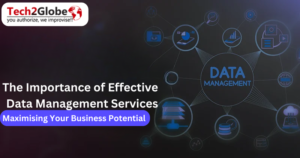Understanding The Differences Between Data Migration And Data Conversion To Pick The Best Approach
Data convrsion and data migration are not the same things, despite their similarities. To make informed decisions about business operations and infrastructure, you must be aware of the distinction. Read on to learn what these methods include, when to use each one, and how to be certain that the plan you choose will best suit your needs.
An Overview Of Data Management
The process of gathering, storing, and using data in an efficient, productive, and secure manner is known as data management services. Its fundamental objective is to help businesses use data more effectively, facilitate decision-making, and adhere to corporate and regulatory obligations while benefiting the businesses themselves. The importance of an efficient data management company strategy has increased as businesses increasingly rely on digital assets to generate value.
Bringing together data from many sources is one of the biggest problems engineers face. Because there are so many of them, it can be challenging to combine data from various sources and storage tools into a single file format. A predetermined, repetitive pattern must also be followed by the integration process itself.
Effective outsource data management services also requires adherence to particular quality and security standards. Businesses must meet deadlines without compromising the consistency and integrity of the data, for example, in order to guarantee client pleasure. Businesses run the risk of losing consumers and wasting money if they ignore data quality.
Data transfer and conversion are crucial processes in our data-driven culture.
Understanding Of Data Migration
Transferring information from one system to another is essentially what data migration entails. This may be necessary for organisations for a number of reasons, such as system improvements, data compliance, corporate mergers, etc. Whatever the reason, be sure that when you transfer your data from one system to another, it is still complete, usable, and accessible.
The principal benefits of data migration are as follows:
- Increased Operational Effectiveness: Businesses can build an organized environment where knowledge is always available by shifting data to a new system. This improves data handling and administration in addition to upgrading and making it easier for staff members to perform. It also lowers the likelihood of human mistakes, which can be expensive to rectify. As a result, companies could concentrate more on crucial tasks without being continually distracted by troubleshooting. Startups may improve their brand recognition in the marketplace, especially when they employ premium cloud storage like AWS.
- Agile Business Processes: Increasing an organization’s agility is one of the main advantages of data migration. Because technology advances more quickly than we can keep up with it, you can prepare yourself by always being prepared for an update. This covers hassle-free system switching and dependable shutdowns. Because the cloud provides the most flexibility and agility for data movement, modern businesses are moving to it.
- Better Decision-Making: Data migration enables businesses to make choices based on up-to-date knowledge and insights. This information may be utilised to base projects, services, and products on educated customer demand and trends, which has immense power for decision-making and guiding the business in the proper direction.
For companies using old systems, performing analytics, and, if cloud software is employed, having access to data from any location and device, are two of the key advantages of moving data to modern software.

What More?
Despite the fact that data migration has many advantages, we must also talk about any possible drawbacks. These include:
1. Data loss: If data migration is not properly supervised and handled, data loss may result. All of these factors, as well as the most frequent culprit, human error, can lead to system failures.
2. Compatibility Issues: For organisations, making sure the data structure can be understood by the system being received is the top priority when transferring data across systems. They need to be prepared to spend a lot of work on making it compatible in different circumstances.
3. Downtime: Data transfer to a new system takes time and may result in protracted downtimes, which could lead to potential revenue loss.
Experience With Data Conversion
When one data format is converted into another, a data conversion services takes place. The technological procedure is often carried out using software; hardware or human input is only occasionally used. Interoperability and maintaining all of the data while retaining as much data as is practicable are the only goals of the data conversion.
Data conversion into numerous formats can be very challenging depending on the environment and the sorts of data involved. However, it has a number of benefits, the most important of which are:
1. Higher Data Quality: Data is subjected to numerous checks and verifications before being converted between formats. This process helps to ensure that the data is correct and free of errors.
2. Improved Accessibility: Data formats vary depending on the platform or app. By converting data, businesses increase their compatibility and interoperability with other platforms. As a result, data is then more readily available.
3. Improved Data Analytics: Data translation frequently reveals issues that were previously undetected. For instance, the company can be utilising and archiving data in an out-of-date format, which makes analysis more difficult. By converting data into new formats, businesses may unlock unrealized potential and gain a competitive advantage.
4. Easy Migration Of Data: Data migration is commonly combined with data conversion, making it straightforward. This is owing to the fact that formatting data into an alternative format is frequently required when moving data between systems.
There are various drawbacks to data conversion, including:
1. More Errors: Error probability is raised whenever data is transformed since mistakes might happen at any time. This danger increases as data is converted. Any inconsistencies in the data could lead to incorrect analysis and subpar decision-making.
2. Time And Resource Intensity: Data translation is frequently a challenging process that requires a significant investment of time, personnel, and funds to execute.
3. Compatibility Problems: The data transformation can fail to be compatible with present software or hardware, which could make integration challenging. Organisations must carefully weigh all the advantages and disadvantages of the process in order to receive the best results from the outsource data conversion services process.
Differences Between Data Migration And Data Conversion
Data migration and data conversion differ primarily in the process itself. There are a few basic steps that all conversions go through, even if each database conversion job is unique.
- Evaluating the data from both the source and the target databases.
- Deciding on a strategy based on the project’s specifications and the end user’s expectations.
- After at least three repetitions of the conversion test, the findings are examined for validity.
- Converting the data into the format needed by the destination database to implement the strategy.
- Assessing the results’ quality in conclusion.
The need to understand both the source and the new format increases the complexity of database conversion. Data integrity could be lost or jeopardized without this information. Other factors to consider are data duplication that may need to be merged, outdated information that must be updated or removed before conversion, and inaccurate information that may need manual correction.
Data accessibility and consistency maintenance is the essential aim of data transport. Reviewing the current database, data mapping to identify any potential changes, moving the information to the new database, and lastly testing to ensure that all the data has been transferred correctly are the steps in the outsource document processing services.
However, although Outsource Data Management Services USA may appear straightforward at first, it is actually quite challenging. It’s possible that outdated data will be lost during the transfer process. Previously, as part of best data conversion services, the procedure needed to guarantee that data sets are precisely mapped throughout migration is frequently carried out. Before commencing a database migration, planning is essential.
Conclusion
You can move information from one place to another by copying and pasting. When millions of data pieces need to be imported into a new system, anything becomes considerably more difficult. Every modern organisation needs data management services, yet a lot of them consider data migration to be a simple operation.










